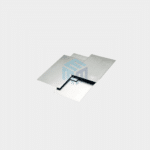The maximum heating rate for a quartz crucible depends on various factors, including the size and thickness of the crucible, the quality of the quartz material, and the specific application or process you are using it for. However, there are some general guidelines to consider:
- Gradual Heating: It’s generally recommended to heat quartz crucibles slowly and gradually, especially during the initial stages of heating. A common practice is to limit the heating rate to around 100-200°C (180-360°F) per hour during the early stages of heating to prevent thermal shock, which can lead to cracks or breakage.
- Annealing Process: If you are working with a new or freshly cleaned quartz crucible, it’s advisable to perform an annealing process before subjecting it to rapid heating. Annealing involves slowly heating the crucible to a specific temperature (usually around 800-1000°C or 1472-1832°F) and then gradually cooling it to relieve internal stresses and ensure uniform thermal expansion.
- Temperature Uniformity: Quartz is sensitive to thermal gradients, so it’s essential to ensure that the heating is uniform across the crucible to prevent localized stress and potential cracking. Use a heating method that provides good temperature distribution, such as a furnace with a controlled heating profile.
- Crucible Thickness: Thicker quartz crucibles can typically handle higher heating rates than thinner ones because they have better thermal stability. Thinner crucibles are more susceptible to thermal shock.
- Application Considerations: The specific application or process you are using the crucible for can also influence the maximum heating rate. Some processes may require slower heating rates to ensure precise control or to avoid reactions with the quartz material.
- Manufacturer’s Recommendations: Always consult the manufacturer’s guidelines and recommendations for the specific type and brand of quartz crucible you are using. They may provide maximum heating rate specifications and other important information.
Read also: Benefits and Uses of Quartz Crucibles
In summary, while there is no fixed maximum heating rate that applies to all quartz crucibles, it’s crucial to consider factors like crucible thickness, annealing, temperature uniformity, and the manufacturer’s recommendations when determining the appropriate heating rate for your particular application. Gradual heating and controlled temperature profiles are generally safer to avoid thermal stress and potential damage to the crucible.
Consulting with M-Kube Enterprise experts or referring to literature in your field can also provide valuable guidance in bringing more clarity to this topic. M-Kube Enterprise is a USA company catering products and solutions in the USA, Australia, New Zealand, Singapore, Malaysia, South Korea and Vietnam. Our team of experts across different platforms can discuss and customize your requirements as per your needs.






